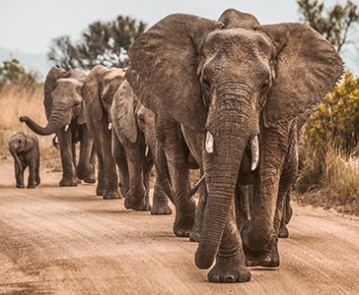
“Nature’s great masterpiece, an elephant; the only harmless great thing.”
– John Donne
I just got back from a month in India where I saw some beautiful elephants, an animal that’s revered in that ancient country. It’s said that these pachyderms have steeltrap memories – none of the senior moments that have been plaguing far too many nonseniors in our hyper fastpaced lifestyle that requires us to process more information at greater speeds than the human brain was built for. And elephants live nearly as long as human beings, with 70 years not at all uncommon for African bush elephants, and African forest ones, as well. That’s pretty remarkable considering the fact that the former carries some 13,000 pounds.
Among the people of India the elephant is a sacred animal. The Hindu god Ganesh, who’s worshipped as the remover of obstacles, is depicted as an elephant. It’s also the state animal of Kerala, one of India’s western states. Speaking of India, when Alexander the Great conquered its King Porus, the former used the elephant as a symbol of imperial power. Closer to home, the Republican Party has used it as its logo.
But aside from their grace and power, elephants are most noted for their memories. Neurologists have determined that the brains of elephants have as many cortical neurons as the brains of human beings. What’s more, these beautiful creatures have larger pyramidal neurons than we do – these cells are believed to exert a significant role in cognitive skills. This suggests that the memory and learning skills of the elephant are actually superior to ours.
Unlike elephants, human beings have created such technological achievements as the computer, which contains extraordinary memory. It’s possible that as we rely on computer RAM (Random Access Memory) our own memories have gotten less efficient. Far too many humans are known to walk into a room and ask themselves, “Now why did I come here?” Senior moments are growing way too fast in our postindustrial world.
Yet despite this devolution, it’s important to understand that we as a species have an untapped memory skill that has been documented in the spiritual literature of Yoga. I sat in on a talk given by the great guru Maharishi Mahesh Yogi who spoke of a state of consciousness known as Ritam Bhara Pragya, which he defined as “that intelligence which knows only the truth.” When a person’s awareness has been permanently established in pure consciousness – in other words, Enlightenment – it’s possible to enliven this Ritam state. In other words, one can remember whatever has happened in one’s life if Ritam is lively.
The metaphysical systems of Theosophy and Anthroposophy talk about the Akashic Records, which are said to contain everything that has ever happened, been spoken, thought, or felt in the Universe. They maintain that such records exist on a nonphysical level called the mental plane. The word Akashic is derived from the Sanskrit word akasha, which means ether, sky, or atmosphere.
So at a time of declining human memory, the elephant reminds us that memories can be sharper. And that if we slow down a little – perhaps moving with the dignity and patience of this great creature – we might awaken our own pure consciousness, enliven Ritam Bhara Pragya and read from the Akashic Records.
